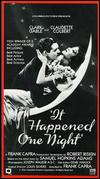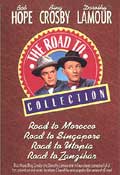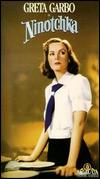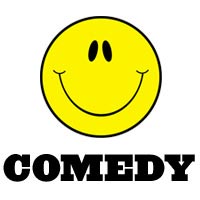Screwball Comedy:
Screwball comedies were launched in the mid-1930s, and established
their place after the advent of film sound and the social disturbances of
the Depression. This form of comedy provided by a new generation of writers
and directors offered escapist entertainment for Depression-era audiences
through much of the 30s and into the 40s - especially after the strict enforcement
of the Hays Code took effect. Screwball comedies were characterized by social
satire, comedic relief through zany, fast-paced and unusual events, sight
gags, sarcasm, screwy plot twists or identity reversals, and precisely-timed,
fast-paced verbal dueling and witty sarcastic dialogue - blending the wacky
with the sophisticated.
Screwball comedies often took an anarchic tone or irreverent
view of domestic or romantic conflicts ('battles of the sexes'), and usually
aimed their barbs at the leisure-upper class. The main feature of a screwball
comedy was the total disruption of a hero's ordered, unhassled life by a heroine.
[Screwball comedies often presented actresses with their most complex and
challenging roles.] The hero and heroine, both antic characters united by
romance, were usually of different social, sexual, and economic stratas, and
thrown together in ridiculous, improbable, unlikely situations and comic misadventures.
Ultimately, their antagonistic conflicts and class differences were happily
resolved when they fell in love, were reconciled together, or married.
 The
earliest screwball comedy was Lewis Milestone's The Front Page
(1931) (remade in 1940 by director Howard Hawks as His
Girl Friday (1940)), although some consider Hawks' raucous Twentieth
Century (1934) (with
John Barrymore and Carole Lombard) the most definitive screwball comedy.
Frank Capra, the star director of Columbia Pictures, directed the successful It
Happened One Night (1934) earlier in the same year, featuring
the sparring of Clark Gable as a cynical, hard-times reporter and
Claudette Colbert as a pampered, runaway heiress. Even though Howard
Hawks had three classic screwball comedies, Capra's 1934 film is the
seminal example of this sub-genre, and the highly popular film was
the first to win the top
four Academy Awards: Best Picture, Best Director, Best Actor, and Best
Actress. The
earliest screwball comedy was Lewis Milestone's The Front Page
(1931) (remade in 1940 by director Howard Hawks as His
Girl Friday (1940)), although some consider Hawks' raucous Twentieth
Century (1934) (with
John Barrymore and Carole Lombard) the most definitive screwball comedy.
Frank Capra, the star director of Columbia Pictures, directed the successful It
Happened One Night (1934) earlier in the same year, featuring
the sparring of Clark Gable as a cynical, hard-times reporter and
Claudette Colbert as a pampered, runaway heiress. Even though Howard
Hawks had three classic screwball comedies, Capra's 1934 film is the
seminal example of this sub-genre, and the highly popular film was
the first to win the top
four Academy Awards: Best Picture, Best Director, Best Actor, and Best
Actress.
A third film in the same year, a screwball comedy-mystery The Thin Man (1934), was a comedic adaptation
from a Dashiell Hammett novel, about a wise-cracking, sleuthing, party-going
couple (William Powell and Myrna Loy with tremendous screen chemistry in their
first film of the six-part series) with their dog Asta. Fourthly, the musical
screwball comedy The Gay Divorcee (1934) was the first film to co-star
dancing partners Fred Astaire and Ginger Rogers.
The formula for screwball films inspired many more excellent
examples of the sub-genre in future years, such as:
 Gregory La Cava's My
Man Godfrey (1936) with a unusual scavenger hunt that turns up a
"forgotten man" bum (William Powell) who teaches a family and its spoiled
heiress-daughter (Carole Lombard) about life Gregory La Cava's My
Man Godfrey (1936) with a unusual scavenger hunt that turns up a
"forgotten man" bum (William Powell) who teaches a family and its spoiled
heiress-daughter (Carole Lombard) about life- the superb The Awful Truth (1937) from Leo McCarey (Best Director of 1937) with Cary Grant and Irene Dunne
as a squabbling about-to-divorce couple who sabotage each other's efforts
at new relationships
- Nothing Sacred (1937) with Carole Lombard and Fredric
March
- Howard Hawks' quintessential screwball comedy Bringing
Up Baby (1938) with Cary Grant as a straight paleontologist and
Katharine Hepburn as a free-spirited heiress, both in conflict with each
other while caring for a pet leopard named Baby and searching for a dinosaur
bone hidden by her dog
- Cukor's Holiday (1938) with Hepburn and Grant again
and a witty Philip Barry script
- the superior re-rendering of The Front Page in the
newspaper office comedy and the fast-paced war-between-the-sexes film, His Girl Friday (1940), starring Rosalind Russell as a reporter
and Grant as her ex-husband and editor
- George Stevens' screwball comedy set during World War II
in Washington DC, The More the Merrier (1943),
that found Joel McCrea and Jean Arthur cramped together during a housing
shortage
Preston Sturges' Comedies:
 Writer/director
Preston Sturges, one of the greatest comic geniuses, was known for his many
social satires in the 1940s, poking fun at sex/love, politics, war and the
military, and death. He made eight screwball comedies in five years for Paramount: The Great McGinty (1940); Christmas in July (1940); his third
inspired feature Sullivan's Travels (1941),
about a comedy director who quits Hollywood to be a hobo - a satire on Hollywood's
socially-responsible films during the Depression Era; The Lady
Eve (1941) with Barbara Stanwyck in an exceptional role as sexy con
artist Jean Harrington/Lady Eve Sidwich and Henry Fonda as a hapless victim; The Palm Beach Story (1942) with Claudette
Colbert and Joel McCrea playing the archetypal couple; The Miracle of Morgan's
Creek (1944) with Betty Hutton as a wide-eyed, pregnant party-goer unable
to identify the father; the political satire Hail the Conquering Hero (1944);
and The Great Moment (1944). Writer/director
Preston Sturges, one of the greatest comic geniuses, was known for his many
social satires in the 1940s, poking fun at sex/love, politics, war and the
military, and death. He made eight screwball comedies in five years for Paramount: The Great McGinty (1940); Christmas in July (1940); his third
inspired feature Sullivan's Travels (1941),
about a comedy director who quits Hollywood to be a hobo - a satire on Hollywood's
socially-responsible films during the Depression Era; The Lady
Eve (1941) with Barbara Stanwyck in an exceptional role as sexy con
artist Jean Harrington/Lady Eve Sidwich and Henry Fonda as a hapless victim; The Palm Beach Story (1942) with Claudette
Colbert and Joel McCrea playing the archetypal couple; The Miracle of Morgan's
Creek (1944) with Betty Hutton as a wide-eyed, pregnant party-goer unable
to identify the father; the political satire Hail the Conquering Hero (1944);
and The Great Moment (1944).
The 'Road To...' Pictures with Hope, Crosby and Lamour:
 Beloved
entertainers Bob Hope and Bing Crosby partnered together as a wise-cracking,
ad-libbing duo and teamed up with actress Dorothy Lamour in a series of seven escapist
'Road pictures' for Paramount (beginning in the 1940s): Beloved
entertainers Bob Hope and Bing Crosby partnered together as a wise-cracking,
ad-libbing duo and teamed up with actress Dorothy Lamour in a series of seven escapist
'Road pictures' for Paramount (beginning in the 1940s):
- The Road to Singapore (1940)
- The Road to Zanzibar (1941)
- The Road to Morocco (1942) - their best
- The Road to Utopia (1946)
- The Road to Rio (1947)
- The Road to Bali (1952) - the only one in color
- The Road to Hong Kong (1962)
Vaudeville star Bob Hope also starred in a number of other
comedy films in the late 30s and 40s, including My Favorite Blonde (1942) with a trained penguin and co-star Madeleine Carroll as a British spy, and
a spoof of the Old West titled The Paleface (1948) with co-star Jane
Russell as Calamity Jane. Danny Kaye and Red Skelton were also popular comedians
in the 1940s. Kaye first gained attention when he appeared with Gertrude Lawrence
on the Broadway stage in Moss Hart's Lady in the Dark. Afterwards,
when under contract to Samuel Goldwyn, he starred in many musical comedies,
often opposite Virginia Mayo. The 31 year-old's first feature film was Up
in Arms (1944) starring vivacious Dinah Shore (and Virginia Mayo as a
chorus girl).
Various Forms of Comedy:
 Comedies
have been created in many varieties and forms including, for example, the
family comedies, typified by the Hardy Family series with Mickey Rooney as
young Andy Hardy. Gregory La Cava's realistic, sassy/bitchy-woman 30s comedy
about the Broadway theatre titled Stage Door (1937) starred Katharine Hepburn as an aspiring, patrician actress opposite her room-mate
- a plebian, wise-cracking Ginger Rogers. Hepburn also recreated the role
of a spoiled and snobby socialite she had originated on Broadway in MGM's
classic, straight romantic comedy The Philadelphia Story (1940) opposite ex-husband Cary Grant and
lovestruck marriage reporter James Stewart. Comedies
have been created in many varieties and forms including, for example, the
family comedies, typified by the Hardy Family series with Mickey Rooney as
young Andy Hardy. Gregory La Cava's realistic, sassy/bitchy-woman 30s comedy
about the Broadway theatre titled Stage Door (1937) starred Katharine Hepburn as an aspiring, patrician actress opposite her room-mate
- a plebian, wise-cracking Ginger Rogers. Hepburn also recreated the role
of a spoiled and snobby socialite she had originated on Broadway in MGM's
classic, straight romantic comedy The Philadelphia Story (1940) opposite ex-husband Cary Grant and
lovestruck marriage reporter James Stewart.
Excellent examples of supernatural romantic comedies are Here
Comes Mr. Jordan (1941), Heaven Can Wait (1943), Blithe Spirit
(1945, UK) and The Ghost and Mrs. Muir (1947). The
versatile MGM superstar and comic buffoon Danny Kaye played identical twins
with strikingly-different personalities: a timid bespectacled librarian and
a nightclub emcee (who becomes a ghostly spirit and then enters his brother's
body) in the Technicolor, Goldwyn-produced Wonder Man (1945). The singing,
dancing, and joking Kaye also starred in other films with multiple personalities,
including: The Kid From Brooklyn (1946) - a remake of Harold Lloyd's The Milky Way (1936), the Technicolor musical comedy The Secret
Life of Walter Mitty (1947) adapted from James Thurber's short story,
and The Inspector General (1949).
Sophisticated Comedy:
 Depression-Era
social comedies and satires have been categorized as sophisticated comedies.
This sub-form of the comedy genre generally finds humor in the lives and activities
of the rich and urbane, and are marked by witty and sophisticated dialogue,
centering on marital and romantic relationships. A classic example is George
Cukor's sparkling Dinner At Eight (1933) about
a Manhattan dinner party attended by an array of high-society guests (millionaires
and financial predators, washed-up and aging actors, a sexy hatcheck girl
- and more), an adaptation of a Broadway hit by George S. Kaufman and Edna
Ferber. Cukor also directed the all-female The Women (1939), an entertaining
but stinging look at the state of matrimony. Fred Astaire and Jane Powell
starred as a brother/sister dance act (threatened by burgeoning romances)
in MGM's Alan Jay Lerner musical Royal Wedding (1951), a film famous
for Astaire's dancing on the ceiling. A more recent example of sophisticated
comedy is the off-beat, wistful love story of Manhattan party girl Holly Golightly
(Audrey Hepburn) in Breakfast at Tiffany's (1961). Depression-Era
social comedies and satires have been categorized as sophisticated comedies.
This sub-form of the comedy genre generally finds humor in the lives and activities
of the rich and urbane, and are marked by witty and sophisticated dialogue,
centering on marital and romantic relationships. A classic example is George
Cukor's sparkling Dinner At Eight (1933) about
a Manhattan dinner party attended by an array of high-society guests (millionaires
and financial predators, washed-up and aging actors, a sexy hatcheck girl
- and more), an adaptation of a Broadway hit by George S. Kaufman and Edna
Ferber. Cukor also directed the all-female The Women (1939), an entertaining
but stinging look at the state of matrimony. Fred Astaire and Jane Powell
starred as a brother/sister dance act (threatened by burgeoning romances)
in MGM's Alan Jay Lerner musical Royal Wedding (1951), a film famous
for Astaire's dancing on the ceiling. A more recent example of sophisticated
comedy is the off-beat, wistful love story of Manhattan party girl Holly Golightly
(Audrey Hepburn) in Breakfast at Tiffany's (1961).
Ernst Lubitsch:
 German
director Ernst Lubitsch, one of the earliest masters of sound comedy,
was also known for having a sophisticated comedy style called "The
Lubitsch Touch."
His comedies poked fun at the idle rich in a comedy of manners. He
brought his special blend of romance, comedy, and music to the screen
with The
Love Parade (1929), and then with his early 30s erotic comedy Trouble
in Paradise (1932). Later screen classics include his joyous
comedy Ninotchka
(1939) in which the cold-hearted Russian agent (played
by Greta Garbo) fell in love and turned light-hearted - it was advertised
as 'Garbo Laughs'. Finally, Lubitsch directed the romantic classic The
Shop Around the Corner (1940) with James Stewart and Margaret
Sullavan as feuding, lonely-hearts co-workers and pen pals, and
the sophisticated anti-Nazi black comedy To
Be or Not To Be (1942) with Jack Benny and Carole Lombard
(her final screen appearance before a fatal plane crash) as husband/wife
members of an acting troupe in Nazi-occupied, wartime Poland. German
director Ernst Lubitsch, one of the earliest masters of sound comedy,
was also known for having a sophisticated comedy style called "The
Lubitsch Touch."
His comedies poked fun at the idle rich in a comedy of manners. He
brought his special blend of romance, comedy, and music to the screen
with The
Love Parade (1929), and then with his early 30s erotic comedy Trouble
in Paradise (1932). Later screen classics include his joyous
comedy Ninotchka
(1939) in which the cold-hearted Russian agent (played
by Greta Garbo) fell in love and turned light-hearted - it was advertised
as 'Garbo Laughs'. Finally, Lubitsch directed the romantic classic The
Shop Around the Corner (1940) with James Stewart and Margaret
Sullavan as feuding, lonely-hearts co-workers and pen pals, and
the sophisticated anti-Nazi black comedy To
Be or Not To Be (1942) with Jack Benny and Carole Lombard
(her final screen appearance before a fatal plane crash) as husband/wife
members of an acting troupe in Nazi-occupied, wartime Poland.
Frank Capra:
Heartwarming, idealistic "Capra-corn" tales of decent American
little-man heroes who exemplified hard work, common sense, and virtue were
best expressed in director Frank Capra's semi-comedic films: Lady for a
Day (1933), Mr. Deeds Goes to Town (1936),
the zany Best Picture winner You Can't Take it With You (1938), Mr. Smith
Goes to Washington (1939), Meet John Doe (1941),
and the nostalgic, Christmas-time classic It's a Wonderful Life (1946). He was also responsible for the romantic
fantasy film Lost Horizon (1937), and for
brilliantly adapting the black screwball comedy and Broadway stage production
(by Joseph Kesselring) of Arsenic and Old Lace (1944) with Cary Grant - shot in 1941 but released three years later.
 The Teaming of Tracy-Hepburn: The Teaming of Tracy-Hepburn:
The
1940s also brought together Spencer Tracy and Katharine Hepburn for the first
time in Woman of the Year (1942) with Tracy as a brash sports reporter
and Hepburn as a political columnist for a New York newspaper. They starred
in a total of nine films together over a twenty-five year period. Through
the years, there were many great Hepburn and Tracy comedies with a "battle
of sexes" theme, including State of the Union (1948), Adam's
Rib (1949) with the duo as married lawyers on opposite sides in a
divorce case, and Pat and Mike (1952). |
